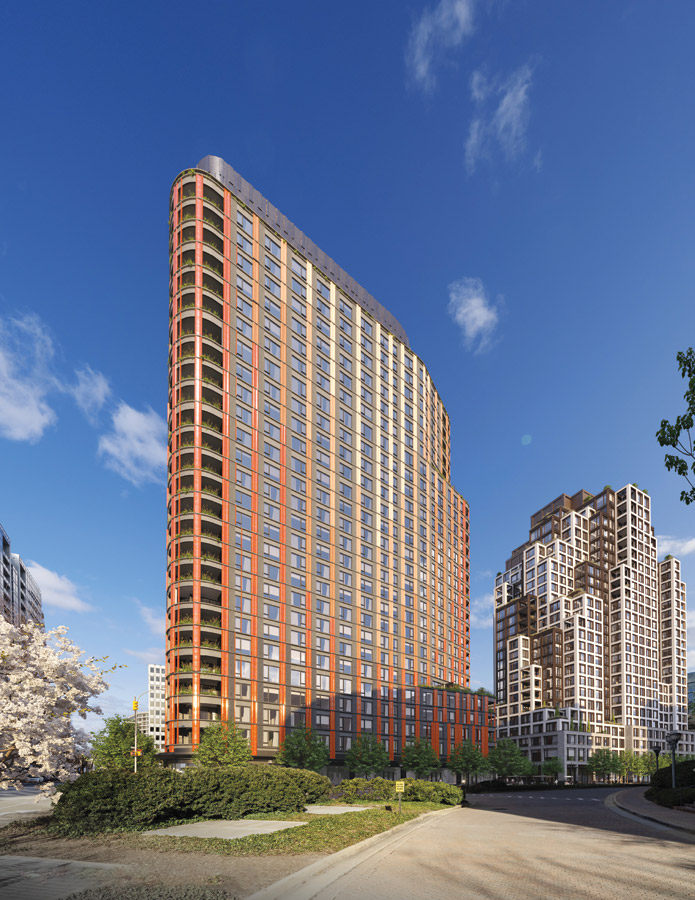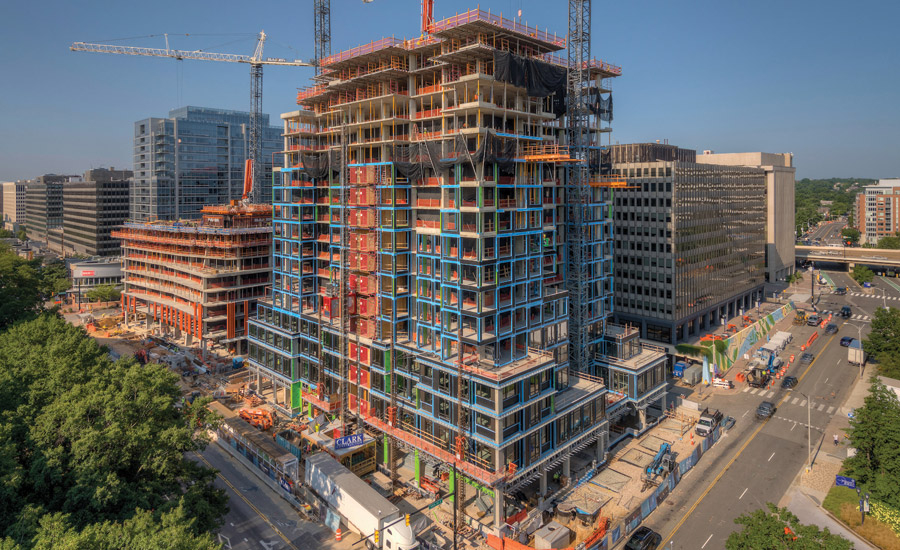Featuring two distinctive residential towers and street-level amenities, the 1900 Crystal Drive mixed-use development in Arlington County, Va., is a milestone in the changing dynamics of National Landing, a rebranded group of neighborhoods long known mainly for their canyons of precast and glass 1960s-era office and residential high-rises adjacent to Reagan National Airport.
Located just a short walk from the planned centerpiece Amazon HQ2 complex, which opened its first phase last year, 1900 Crystal Drive is replacing a demolished 13-story office building with a terraced 583,000-sq-ft north tower, nicknamed the Grace, and a curved 567,500-sq-ft south tower, called Reva, both rising above more than 40,000 sq ft of street-level retail and pedestrian-friendly amenities such as a living street that can double as a setting for programmed events.

The Reva (foreground) has glazed terra-cotta facade panels, while the Grace has a Porcelanosa tile and metal panel rainscreen system.
Rendering courtesy JBG Smith
Completion is Set for Spring 2024.
According to Craig Ciekot, vice president of development for real estate investment trust JBG Smith, 1900 Crystal Drive’s goal of bringing new energy to the neighborhood predates Amazon’s 2018 selection of the area for HQ2, which has sparked a larger-scale, multifaceted redevelopment effort that includes numerous other residential and retail projects, Virginia Tech’s new Innovation Campus, revitalized community spaces and a new entrance to an existing Metrorail station.
Owner of 6.2 million sq ft of existing office space in the National Landing area, JBG Smith began planning the redevelopment of the 1900 Crystal Drive site in 2017. “We looked at the whole neighborhood to see what could be done to make it a more walkable, 24/7 setting,” Ciekot says. Along with meeting the desire for increased residential density, he adds, “we wanted to get away from the car-centric environment to one that was warmer and more welcoming.”
“We want to make sure when our development and future development come on board, the capacity is there.”
— Steven Liam, Principal, Bowman Consulting Group
The towers, designed by Cook Fox with Torti Gallas + Partners as architect of record, do just that, Ciekot says, with the cast-in-place structures differentiated not only from surrounding structures, but from each other. The Grace features a Porcelanosa tile and metal panel rainscreen system rising from a clinker brick-clad podium, while Reva’s facade is a mixture of inset terra-cotta and color precast panels with terra-cotta fins.
“These buildings are narrow towers with continuous setbacks on the facades as they go up,” Ciekot says. “The Grace is rectilinear with cubicles that feature elevated living, while Reva is curved and flowing, promoting a comfortable and rejuvenating experience.”

The 630 augered cast piles drilled 50 to 80 ft deep are topped with a 5-ft-thick mat slab beneath the 115,000-sq-ft building footprint.
Image courtesy Torti Gallas + Partners
Subsurface Solutions
As is often the case with major redevelopment efforts in already densely developed settings, the biggest challenges to turning 1900 Crystal Drive’s vision into reality lay underground. Some, such as locating and bypassing a variety of utility networks, were “par for the course for this kind of environment,” according to Steven Liam, a principal with civil engineer Bowman Consulting Group Ltd. He adds that the interconnectedness of the area’s existing developments meant that “relocations had to be carefully planned as many of the lines served adjacent buildings.”
Because the area’s long-term development plans called for significantly more residential uses, it was also essential to assess the capacity of storm and sewer systems. “Residential buildings have double or even triple the demand of a comparably sized office building,” Liam says. “We wanted to make sure when our development and future developments come on board, the capacity is there.”
Bowman’s comprehensive sewer study, conducted with Arlington County engineers, determined that while the basic infrastructure would be up to the task now and in the future, 1900 Crystal Drive would require nearly 250 ft of new sewer laterals to replace undersized existing connections.
A larger underground challenge awaited general contractor Clark Construction, which joined the project in 2019 and began field work with demolition of the original office building in early 2021. Clark senior project manager Joe Shook says that because the design for the new towers called for excavation 30 ft below street level, Clark would have to cut through a 17,000-sq-ft section of a sprawling two-level subterranean garage that had been built to serve the site’s original building as well as three still-occupied office buildings and a hotel.
To keep the remainder of the garage open through construction, Clark would have to cut into and reinforce the existing 5-ft-thick cast-in-place waffle slabs and construct a new two-level access ramp.
“Our new excavation was 12 ft deeper than the existing garage, so we underpinned the existing foundation on that side,” Shook says. “In the remaining garage, we also installed waterproof partitions and a crash barrier to separate the remaining active area from where we’d be excavating.”
“We went in knowing that we had to be aggressive with approvals and long-lead release dates.”
—Joe Shook, Senior Project Manager, Clark
Clark crews then demolished the original building’s concrete caissons to the new elevation and doweled in new rebar to provide additional soil enhancement. For the primary foundation system, 630 augered cast piles were drilled 50 to 80 ft deep. The piles are topped with a 5-ft-thick mat slab beneath the new 115,000-sq-ft building footprint and a 5-ft-thick slab-on-grade beneath the new parking levels that were subsequently tied back into the existing garage.
Meanwhile, the project team was coping with the pandemic and its associated supply chain disruptions, which overshadowed the planned 2021 start of vertical construction. Of particular concern were specialty facade elements coming from overseas—the Porcelanosa tile from Spain, glazed terra-cotta panels and clinker brick from Germany and unit cabinetry from Poland—as well as more conventional mechanical, electrical and plumbing system components.
“We went in knowing that we had to be aggressive with approvals and long-lead release dates, and the owner worked with us to get submissions through the process as early as possible,” Shook says. “We had extra storage areas available so that we could store material until it was needed.”

Site-wide below grade concrete garage decks finished construction at the southwest corner in March 2022 while fourth floor concrete deck construction was underway at the northeast corner of the site.
Photo courtesy Clark Construction
Upward Bound
The planning has helped the towers’ tightly scheduled nine-month vertical construction phase go “like clockwork,” Shook says, topping out in November 2022. Facade installation followed the concrete work upward, with components stored on floors as they were added.
The only major issue involved the tower cranes’ gradual rise to more than 420 ft above street level, which required coordination with the Federal Aviation Administration to ensure there were no safety impacts to airport operations. Certificates of occupancy for both towers are expected to be in hand by the start of 2024, with phased turnovers taking place through April.
Totaling more than 800 units, the towers will feature a biophilic design inside and out with irrigated planters, view corridors to complement amenities, fitness centers, pools and game rooms.
With redevelopment activity likely to increase as other existing urban neighborhoods look to adapt to changing economies and lifestyles, Ciekot says 1900 Crystal Drive offers valuable lessons for helping streamline delivery of such projects, particularly the early submittal review and approval.
“It was great to see how that relieved some of the stress of the supply chain,” he says, adding that the approach is equally beneficial under normal circumstances. “Getting that through that process early helps free up energy and focus on the project.”
Shook agrees, crediting the close involvement of Arlington County and the community in the first of what will be a wave of change to the National Landing area. “Engaging them early helped build and sustain a positive working relationship from the outset,” he says.
For Liam, just being part of such a transformational project provided plenty of inspiration. “Viewed from the airport or other locations, you can see what a change it brings to the skyline,” he says. “It’s a great project.”




